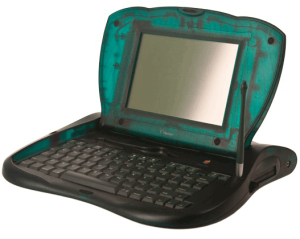The machine’s colorful case, which later inspired the iMac and the iBook, launched a new era in Apple design—though few realized it at the time. In fact, few people could actually buy the rugged machine when it launched in March 1997, as Apple offered it for sale only through education channels.
With a 25MHz ARM CPU, 1MB of RAM, and 2MB of flash memory for document storage (unusual at a time when most PDAs used battery-backed RAM), the eMate wasn’t made for heavy lifting. Instead, Apple designed it as a low-cost educational computer for children.
Indeed, the eMate was one of the cheapest computers Apple had ever made. Its $799 price (which is equivalent to about $1151 in today’s dollars when adjusted for inflation) made it seem like a steal compared to Apple’s flagship notebook at the time, the PowerBook 3400, which retailed for $4500 in its most bare-bones configuration (that’s about $6485 today, and it wasn’t even gold-plated).
A new educational manifesto
Tucked into the eMate’s first product spec sheet is a brief tract that lays out the basics of a bold educational ideology. It’s slathered in marketing lingo (they called it a “Distributed Learning Environment”), but it’s there.
Essentially, Apple wanted to put a cheap, portable, rugged computer in the hands of every child. It wanted to make the device easy to use and interoperable in a world full of both Windows and Mac machines. And it wanted the eMate to be network friendly—both peer-to-peer (via IrDA transfers) and peer-to-Internet. Sound familiar?
Those are all features that would be replicated a decade later in the highly publicized One Laptop Per Childinitiative that produced the rugged, portable XO-1 laptop.
Interestingly, the eMate 300 did not gain significant traction in the educational sector, but the very features that Apple designed to appeal to school administrators—low cost, ease of use, ruggedness, and long battery life among them—ended up appealing to the government market in ways that Apple did not expect.
For example, in 1997, the Largo, Florida police department announced plans to outfit 20 of its patrol cars with eMate 300s for wireless arrest reporting from the field. A news report from that time also mentions that the department was waiting for Apple to produce a less-colorful “business version” of the eMate (which never happened). And according to one Newton fan page, Australia was planning to replace all of its government PCs with eMates, but Apple pulled the plug on the entire Newton line before that could happen.
Translucent accessibility
At the time of the eMate’s release, all of Apple’s desktop computers sported platinum gray cases, and its laptops came cloaked in charcoal gray. In the midst of that conservative color palette, Apple’s Newton division brought forth a translucent dark emerald green computer with playful curves, bulbous corners, and a prominent carrying handle.
Frankly, it looked like a toy, and for good reason: It was an educational product, and Apple designed it to appeal to children. Translucency worked well in that regard. According to the eMate’s primary enclosure designer, Thomas Meyerhoffer, Apple designed eMate’s translucency to evoke a sense of accessibility—in that one could see the unit’s interior components, and nothing would be hidden from the user.
Apple’s pre-Steve Jobs experiments with translucent plastics, especially in the eMate 300, proved to be very important to Apple’s fate. Without the eMate, there would have been no iMac—at least not what we recognize as the iconic early translucent models today.
A Newton PDA at heart
As a member of the Newton family, the eMate allowed users to draw or write (via handwriting recognition) with an included stylus on its 480-by-320 backlit grayscale LCD. It could run any software written for Newton OS 2.0, which also powered Apple’s handheld MessagePad PDA devices.
One of the eMate’s biggest strengths as a portable learning machine was its set of built-in applications included in 8MB of ROM. With a push of a button, users could call up an integrated office suite that included word processing, spreadsheet, and drawing capabilities.
Apple also offered NetHopper, a Newton-based Web browser, and a Eudora email client on CD-ROM (installable through a Mac connection) as a nod to its Internet capabilities. Users could add a modem or ethernet card to a PC Card slot on the side of the machine to hook up to the Net, but Apple did not include any network adapter in the box.
A colorful legacy
To this date, no sales records for the eMate have ever been released, but many believe that the machine, which was highly regarded by the press, had the potential to be a best-selling product if Apple had made it more widely available.
In September 1997, the eMate received a significant endorsement as a product with a “bright future” from an authority no less than Steve Jobs himself as part of an email to a customer. The about-to-be interim CEO clearly appreciated its vision and design, although the eMate, first announced in December 1996, originated from an Apple without Jobs.
Ultimately, Steve Jobs knew that Apple could only survive in that troubled time if it focused on its core business (the Macintosh), so the entire Newton line met its end in early 1998, much to the chagrin of Newton fans everywhere. The eMate died with it, but its legacy lives on. Its innovative visual design helped catalyze a new era of success for Apple, and its role as a low-cost learning machine for kids has now been fulfilled very well by the iPad.





